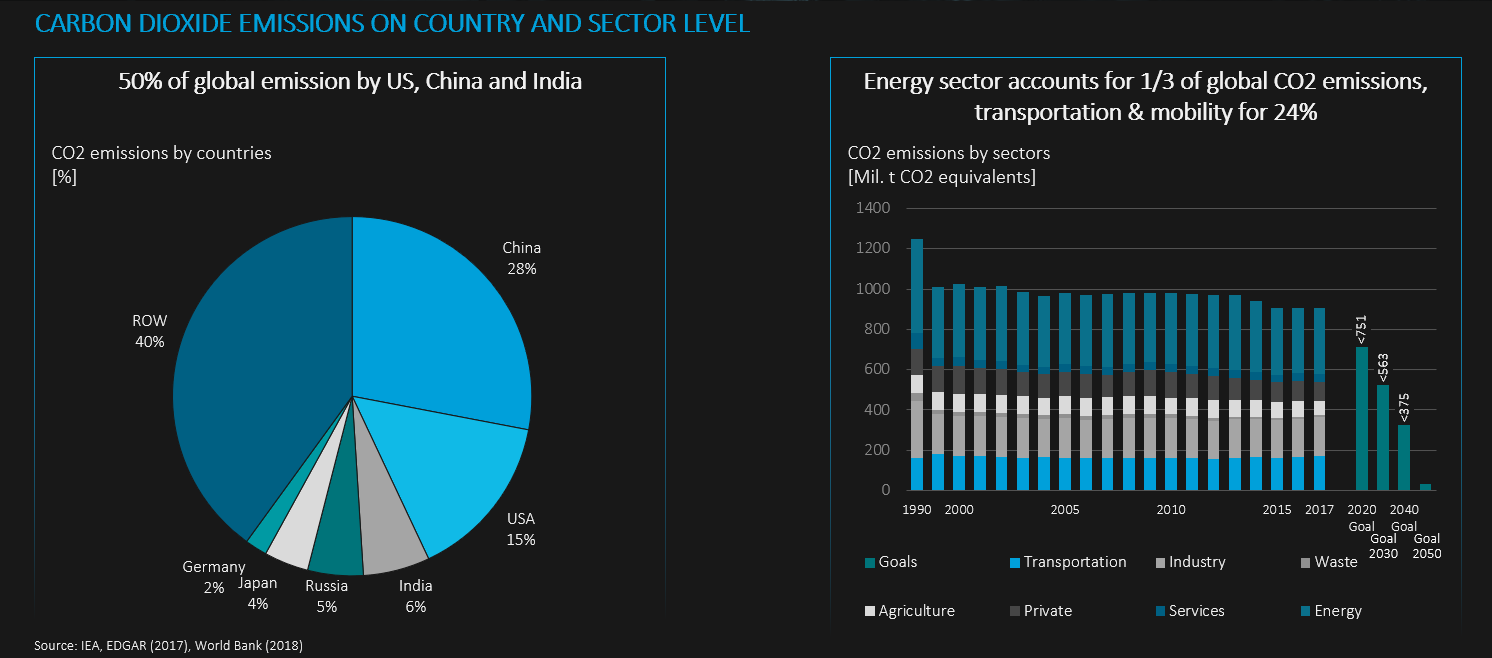
It’s an old discussion with a lot of biased arguments being repeated continuously. What is clear: Climate change keeps progressing with global carbon dioxide emissions constantly increasing. To slow global warming down, carbon dioxide emissions need to be reduced fast and significantly.
The discussion evolves around symbolic actions
However, a huge part of the discussion on how to achieve this goal does mainly evolve around more or less symbolic actions without any major impact. This is especially true for the transportation and mobility sector. Limiting long-distance air travel, prohibiting domestic flights, introducing speed limits, just to name a few of these actions supposedly saving our planet. Everybody even only having a rough idea about the facts and numbers can see the flaw. Having a look at the global carbon footprint, we realize that the aforementioned measures will only have a very minor, sometimes not even measurable impact. Just to make it clear: These actions won’t save the climate!
Why not? And how can our measures achieve a maximum impact? What are the major levers for carbon dioxide reduction?
Country and sector views reveal the major levers
To identify the major levers, we should have a look at the situation from two angles. On a country level, around 50% of global emissions are caused by the United States, China and India only. On a sector level, the energy sector causes about 1/3 of emissions. Transportation and mobility accounts for about 24%. Further detailing these emission, road vehicles emit 18%, air travel and ships both emit about 2.5%, 1% are caused by other means of transportation (e.g. rail).

Carbon dioxide emissions on country and sector level
Countries with the largest emissions in transportation are the United States, China, Russia and India. And the emissions are expected to increase in the future, especially with emerging countries in Asia whose transportation sectors are growing rapidly. These numbers make clear how insignificant measures like prohibiting domestic flights in France or introducing a speed limit in Germany are in the global context. The impact won’t even be measurable.
There are two different approaches to address CO2 reduction taking into consideration the sector and country level view.
Leveraging mobility technology and innovation
On sector level, we need to leverage technology and innovation. This means that we need to develop green, carbon-neutral technologies and innovations. In the transportation and mobility field, climate-neutral technologies can be battery technology for electric cars, hydrogen-based fuel cells for trucks and aircrafts, alternative fuels for conventional cars with internal combustion engine. Moreover, we need to fully electrify our public transport (e.g. electric buses) and at the same time enhance digitalization and multi-modal mobility to push shared modes such as car and ride sharing connected with and to our public transport.
If we manage to make these technologies not only carbon-neutral but also economically beneficial, then other countries will also adopt them. Even if they only doi it to save cost. The economic argument is an important one since otherwise we cannot make sure that major emitting industry nations and emerging countries are following our decarbonization approach.
By focusing our R&D efforts on these technologies, their positive climate impact can be leveraged across countries and is not restricted to only limited geographies (e.g. Europe). An even further step could include an open source approach. Being driven by a higher cause and being open-minded, our companies owning property rights such as patents could make their technologies and innovations available to the public on a global scale. This would further increase the speed of change.
Investing with maximum impact per Euro spent
It is clear that stopping climate change can only work pursuing an international approach. Therefore on a country level, we need to invest money where the impact on carbon dioxide reduction for each Euro invested is the highest. Usually, money invested in developing countries results in much higher carbon dioxide reductions than the one invested in developed regions such as Central Europe. In an extreme case, not switching off an efficient coal-fired power station could be a rational choice. Instead of investing in expensive green energy options to replace the efficient coal-fired plant in Europe, replacing an old coal-fired power station in Africa by a modern one can have a higher CO2 effect per Euro invested. It is key to leave a primarily country-based view and allocate resources globally to generate the highest carbon dioxide reductions.
The benefits of this approach are twofold. By moving away from symbolic actions just for our peace of conscience, we focus on measures with real impact. And thinking of our (European) economy, we develop the technologies of the future to export globally and to guarantee our wealth, strengthen our social welfare and create meaningful jobs.

Leave a Reply